Intel Celeron G540 and Celeron G440 Processors Review

The junior processor models on Sandy Bridge microarchitecture for LGA1155 systems have finally arrived. Let’s take a closer look at the sacrifices you’ll have to make in order to get a contemporary platform with minimal financial investments.
The life span of the LGA775 platform is finally coming to its logical end. It seemed like there was nothing that could take this socket off balance after 5 years of success. However, within the next few months the LGA775 processors will most likely be finally discontinued and Intl will start offering new more up-to-date parts targeted for contemporary platforms.
Of course, in the past few years LGA775 wasn’t a universal or popular platform anymore. The launch of a progressive Nehalem microarchitecture made LGA775 processors step back, as they were inferior to the newcomers in performance. However, Pentium and Celeron processors for LGA775 remained irreplaceable in the entry-level segment for quite some time – neither LGA1156 nor LGA1366 were spreading into the low-end part of the market.
The new LGA1155 platform and the new Sandy Bridge processor family changed the situation dramatically. Intel decided to use them as the basis for their new “blanket” platform that is why the launch of high-performance second-generation Core processors was followed by LGA1155 Pentiums shortly after. By the way, these processors turned out worthy successors to their older brothers and have significantly increased the performance level of the inexpensive systems very rapidly. Now we are at the final stage of the line-up updating and shortly after the new Pentiums Intel releases very affordable Celeron series processors for LGA1155 socket. This is the final milestone in the history of the LGA775 form-factor. Replacing the old first-generation Core microarchitecture with the new Sandy Bridge offering higher performance level will definitely do the trick and the outdated Celeron processors for LGA775 systems will have no appeal left about them from now on.
Nevertheless, the long-lasting popularity of the cheap LGA775 processors is a very interesting phenomenon. And it definitely has a good explanation behind it. We assume that only with the launch of Sandy Bridge microarchitecture and mastering of the 32 nm process Intel could finally create processors, which production cost could compare with that of 45 nm Wolfdale-3M CPUs. For example, the die size of the junior LGA775 processors is 82 mm2. The die in dual-core Sandy Bridge CPUs with the pretty fast graphics core inside is 131 mm2 big. Of course, it is about one and a half times larger, but manufacturing simpler single-chip sixth series chipsets as well as unification of the product line-up seem to compensate well for the additional costs during the CPU manufacturing process.
Anyway, the evolution of the Celeron product series that goes back to 1999 continues successfully. And now those who prefer entry-level solutions will get a dual-core processor with the latest microarchitecture and manufactured using the most advanced production technology. Moreover, it will also feature a built-in graphics core with DirectX 10 support and hardware HD-video decoding. And most importantly, all this comes at the same price of $37-$52 per unit. Very attractive offer, don’t you think so? Let’s see of that is indeed the case…
Closer Look at the New Celeron Processors
Over the course of many years Intel has been using the same approach to designing affordable processors. Inexpensive CPUs were made from regular mainstream CPUs by partially or fully disabling certain functional units in them. Later on they started utilizing the same approach to designing higher-end processors – the Pentium series. This time Intel resorted to the same strategy. It makes absolutely no sense to make any engineering or technological modifications for the entry-level processors that is why all dual-core LGA1155 CPUs including Core i3, Pentium and Celeron use the same semiconductor dies. And the availability or lack of certain functions allows to clearly distinguish between the product families.
Pentium processors suffered most in this situation, as the list of differences between them and the Core i3 is quite long. Inexpensive Pentium CPUs not just got lower clock speeds than Core i3, they also do not support Hyper-Threading and Quick Sync as well as AES and AVX instructions.
Celeron turned out a little luckier in this case. Since almost everything they could possibly disable in Sandy Bridge processors has already been disabled in Pentium, they differences from the higher-end series are truly minimal. Celeron processors have smaller L3 cache: it has been reduced from 3 MB to 2 MB. Besides, the entry-level processors work at lower clock frequencies than Pentium CPUs: the maximum frequency of their computational cores doesn’t exceed 2.5 GHz and the graphics core works at 1.0 GHz maximum frequency.
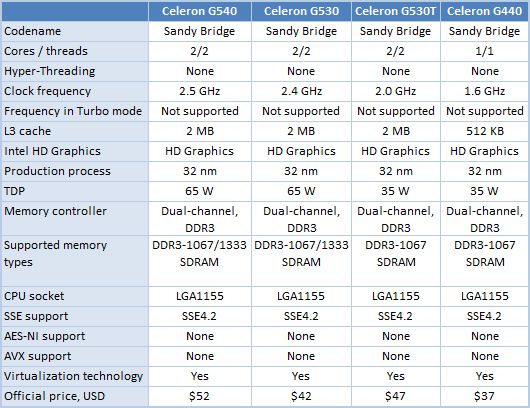
In its initial incarnation the Celeron model line-up consists of four processors: G540, G530, G530T and G440. The first two models are typical dual-core CPUs, and the CPU with a “T” letter in the model name is an energy-efficient model with lowered 35 W TDP. As for the very junior model, the G440, can hardly be considered a Celeron, frankly speaking. This is a single-core “CPU wannabe” with the lowest possible clock frequency, which existence is truly surprising.
The table below shows the major technical specifications of the four new Celeron processors:
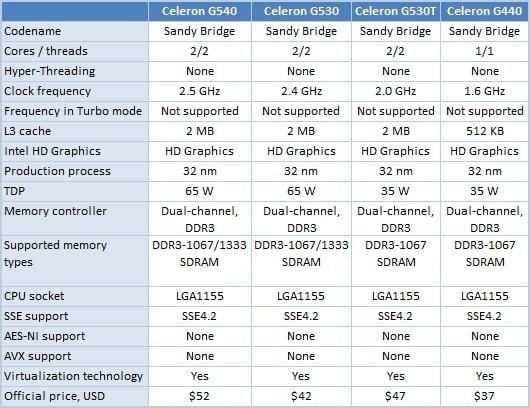
Intel gave us the opportunity to check out two processors from the new product line-up: Celeron G540 and the junior Celeron G440. The screenshots from the diagnostic CPU-Z utility are given below:
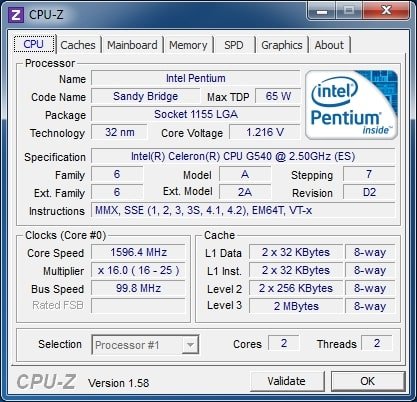
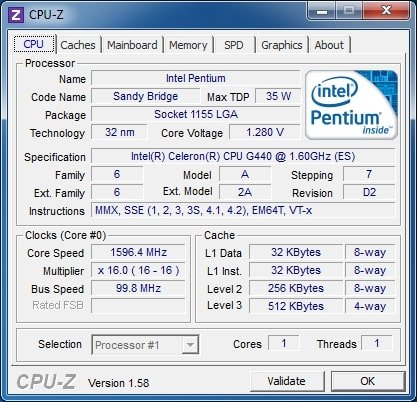
Note that both processors use D2 core revision, which once again confirms that Core i3, Pentium and Celeron processors all use the same semiconductor die. Nevertheless, it is important to remember that these three processor series differ substantially from one another. As you can see from the screenshots, they have different L2 cache size, clock frequencies and the list of supported instructions.
As for Celeron G440 processor, it looks very strange compared with all other products on Sandy Bridge microarchitecture. It is not just the only existing single-core LGA1155 processor, but also works at the minimal clock speed possible, since x16 is the lowest clock frequency multiplier supported by Sandy Bridge. By the way, it means that this processor doesn’t support Enhanced Intel SpeedStep (EIST), because there is no room for lowering its clock frequency in idle mode. We have the feeling that the only reason why Intel made Celeron G440 is to find a way to re-utilize defective semiconductor dies with one non-operational core. Another piece of evidence supporting this assumption is the 6 times smaller L3 cache. However, all this doesn’t mean that Celeron G440 won’t be able to find its market niche.
Testbed Configuration and Methodology
First of all we are going to compare the performance of the new LGA1155 Celeron processors with other products in the same price range. Among them are the old LGA775 Celeron processors and Socket AM3 Athlon II X2. Moreover, to keep the single-core Celeron some company on our diagrams, we also included another single-core processor, which is still around. It is a Socket AM3 Sempron. Besides, we also tested a few dual-core LGA1155 processors from different series in order to estimate how greatly the new Celeron CPUs yield to more expensive Sandy Bridge processors.
Moreover, we will perform a detailed comparison between the new Celeron G440 and two nettop platforms – AMD Brazos and Intel Pine Trail. Therefore, you will see mainboards with integrated AMD E-350 and Intel Atom D525 among the testbed hardware components.
As a result, the complete list of utilized hardware and software components looked as follows:
- Processors:
- AMD Athlon II X2 250 (Regor, 2 cores, 3.0 GHz, 2 MB L2);
- AMD Sempron 150 (Sargas, 1 core, 2.9 GHz, 1 MB L2);
- Intel Celeron E3500 (Wolfdale, 2 cores, 2.7 GHz, 1 MB L2);
- Intel Celeron G540 (Sandy Bridge, 2 cores, 2.5 GHz, 2 MB L3);
- Intel Celeron G440 (Sandy Bridge, 1 core, 1.6 GHz, 512 KB L3);
- Intel Core i3-2100 (Sandy Bridge, 2 cores, 3.1 GHz, 3 MB L3);
- Intel Pentium G850 (Sandy Bridge, 2 cores, 2.9 GHz, 3 MB L3);
- Intel Pentium G620 (Sandy Bridge, 2 cores, 2.6 GHz, 3 MB L3).
- Mainboards:
- ASUS Crosshair IV Formula (Socket AM3, AMD 890FX + SB850, DDR3 SDRAM);
- ASUS P5Q3 (LGA775, Intel P45 Express, DDR3 SDRAM);
- ASUS P8H61-I (LGA1155, Intel H61 Express);
- ASUS P8P67 Deluxe (LGA1155, Intel P67 Express);
- Gigabyte GA-D525TUD (Intel Atom D525, Intel NM10 Express);
- Gigabyte GA-E350N-USB3 (AMD E-350, AMD Hudson M1).
- Memory — 2 x 2 GB DDR3 SDRAM (Kingston KHX1600C8D3K2/4GX):
- DDR3-800 5-5-5-15 with Atom D525 and Celeron E3500 processors;
- DDR3-1067 7-7-7-21 with AMD E-350 processor and in the integrated system with Celeron G440;
- DDR3-1600 9-9-9-27 in all other cases.
- Graphics card: ATI Radeon HD 6970.
- Hard drive: Kingston SNVP325-S2/128GB.
- Power supply unit: Tagan TG880-U33II (880 W).
- Operating system: Microsoft Windows 7 SP1 Ultimate x64.
- Drivers:
- Intel Chipset Driver 9.2.0.1030;
- Intel Graphics Media Accelerator Driver 15.22.1.64.2361;
- Intel Graphics Media Accelerator 3150 Driver 15.12.75.50.64.2230;
- Intel Management Engine Driver 7.1.10.1065;
- Intel Rapid Storage Technology 10.5.0.1027;
- AMD Catalyst 11.8 Display Driver.
The first standard part of our test session was performed in a universal testbed with an external graphics card. The second part of our tests where we compare Celeron G440 against nettop platforms, we utilized graphics cores integrated into processors.
Performance
General Performance
As usual, we use Bapco SYSmark 2012 suite to estimate the processor performance in general-purpose tasks. It emulates the usage models in popular office and digital content creation and processing applications. The idea behind this test is fairly simple: it produces a single score characterizing the average computer performance in different tasks. The diagram below described the contribution of various applications into the final score:
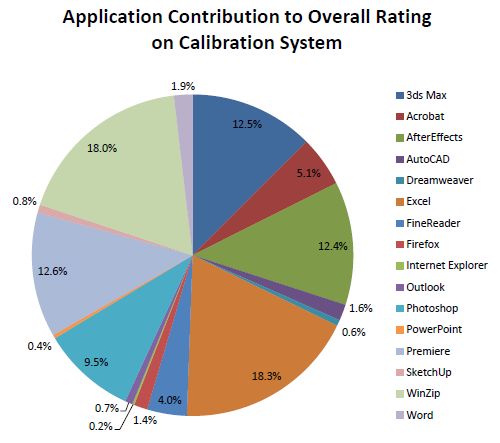
And this is what the distribution of performance results looks like:
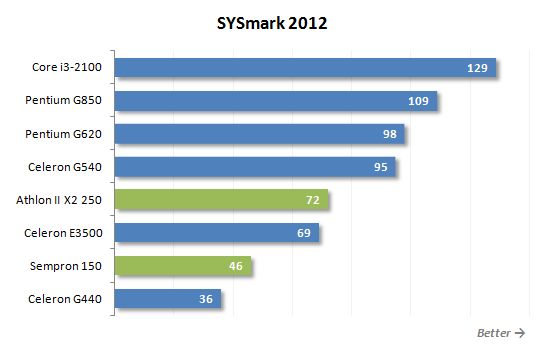
As we have expected, the top dual-core Celeron G540 yields just a tiny bit to the junior LGA1155 Pentium processor. The difference between the two is only 3%. So, it would be fair to say that the new Celeron processors continue to expand Sandy Bridge microarchitecture into the entry segment. The performance difference between Celeron and Pentium is definitely far from what we saw between Pentium and Core i3.
However, we can’t help noticing how superior the new Celeron processors are over their LGA775 predecessors. The transition to a new platform boosted the performance of the entry-level CPUs by almost 40%, as a result Celeron G540 managed to easily outperform inexpensive competitor products.
As for the single-core Celeron G440, its result looks extremely out of place on this diagram. Even a single-core Sempron processor offers significantly higher performance, not to mention dual-core CPUs. Moreover, the performance gap inside the family, between Celeron G540 and G440, looks very unnatural, to put it mildly. The difference in price between the two is 40%, while the difference in performance is over 2.5x!
Let’s take a closer look at the performance scores SYSmark 2012 generates in different usage scenarios.
Office Productivity scenario emulates typical office tasks, such as text editing, electronic tables processing, email and Internet surfing. This scenario uses the following applications: ABBYY FineReader Pro 10.0, Adobe Acrobat Pro 9, Adobe Flash Player 10.1, Microsoft Excel 2010, Microsoft Internet Explorer 9, Microsoft Outlook 2010, Microsoft PowerPoint 2010, Microsoft Word 2010 and WinZip Pro 14.5.
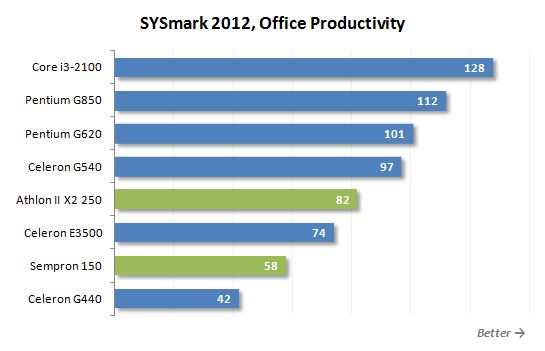
Media Creation scenario emulates the creation of a video clip using previously taken digital images and videos. Here they use popular Adobe suites: Photoshop CS5 Extended, Premiere Pro CS5 and After Effects CS5.
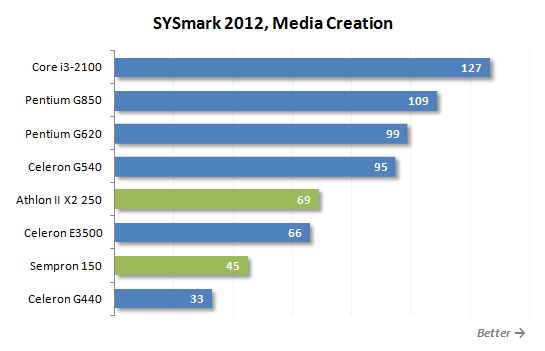
Web Development is a scenario emulating web-site designing. It uses the following applications: Adobe Photoshop CS5 Extended, Adobe Premiere Pro CS5, Adobe Dreamweaver CS5, Mozilla Firefox 3.6.8 and Microsoft Internet Explorer 9.
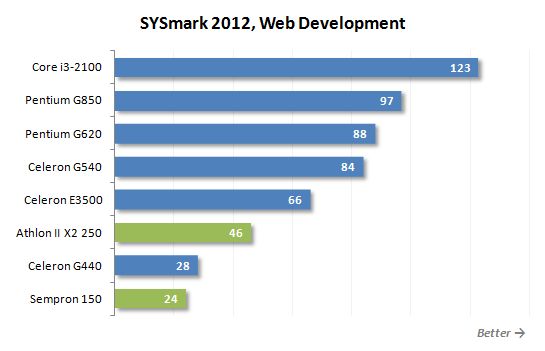
Data/Financial Analysis scenario is devoted to statistical analysis and prediction of market trends performed in Microsoft Excel 2010.
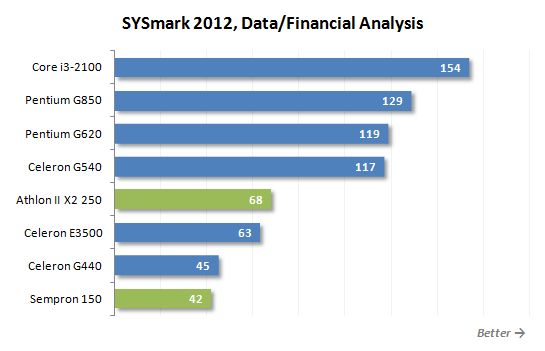
3D Modeling scenario is fully dedicated to 3D objects and rendering of static and dynamic scenes using Adobe Photoshop CS5 Extended, Autodesk 3ds Max 2011, Autodesk AutoCAD 2011 and Google SketchUp Pro 8.
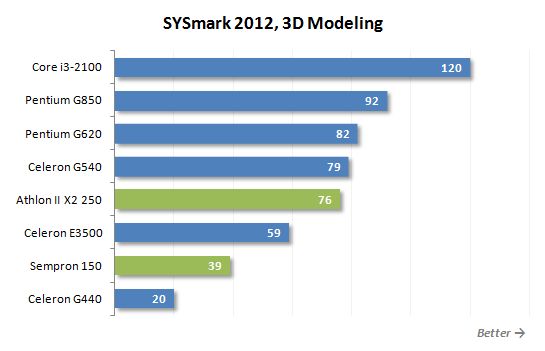
The last scenario called System Management creates backups and installs software and updates. It involves several different versions of Mozilla Firefox Installer and WinZip Pro 14.5.
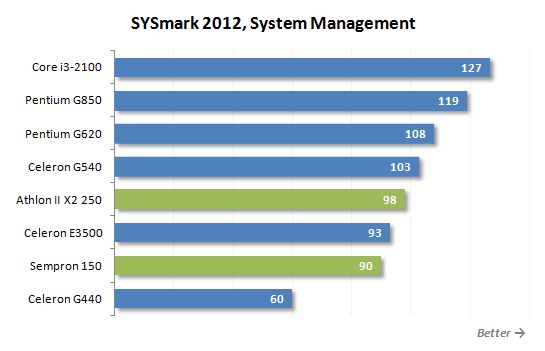
No matter what type of workload there is, Celeron G540 is stably 4% behind Pentium G620, which is most likely determined by the differences in clock frequency. It means that cutting L3 cache memory from 3 Mb to 2 MB (by 1.5 times) is a purely cosmetic adjustment, which has more effect on the subjective perception of the technical specifications rather than the actual performance in applications. So, the slight difference in price between Celeron and Pentium processors has only slight influence on their performance.
Performance in Applications
To test the processors performance during data archiving we resort to WinRAR archiving utility. Using maximum compression rate we archive a folder with multiple files with 1.4 GB total size.
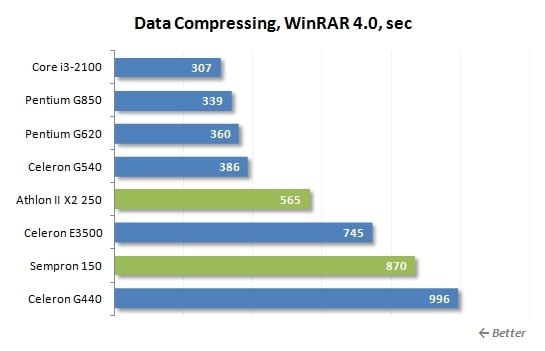
Once Celeron processor migrated from the LGA775 to the LGA1155 platform, its data compression speed has practically doubled. The secret of Sandy Bridge’s success is in support of faster memory. While the old Celeron processors using 200 MHz front side bus can’t clock the memory above 800 MHz, the new Celeron CPUs installed into Intel P67/Z68 based mainboards gain access to a wide range of high-speed memory, including DDR3-1600 or even faster modes, even though there is no mention of that in the official specifications. Therefore, Celeron G540 is so fast in tasks working intensely with large data volumes. As for the size of the L3 cache, its effect on the final results is minimal, as we can see. The difference between Celeron G540 and Pentium G620 processors is only 7%.
We measured the performance in Adobe Photoshop using our own benchmark made from Retouch Artists Photoshop Speed Test that has been creatively modified. It includes typical editing of four 10-megapixel images from a digital photo camera.
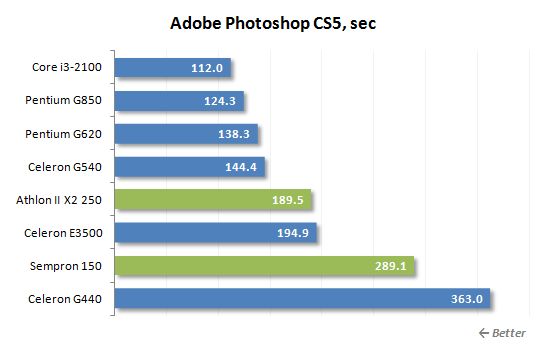
Photoshop tests show that new-generation Celeron processors outperform not only their competitors, but also deliver better performance than Athlon II X2 from AMD. Obviously, as the dual-core Sandy Bridge processors sink into lower-end price segments, the dual-core Socket AM3 CPUs from AMD based on the outdated Stars microarchitecture lose their currency.
We use Apple iTunes utility to test audio transcoding speed. It transcodes the contents of a CD disk into AAC format. Note that the typical peculiarity of this utility is its ability to utilize only a pair of processor cores.
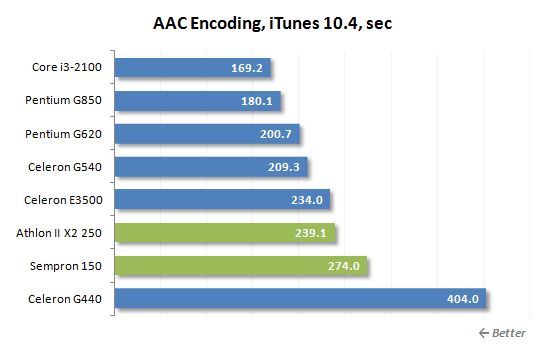
It is interesting that despite a huge difference in specifications between Celeron and Core i3, the performance difference between the two is not so dramatic. Depending on the application, Celeron is 30-50% behind, but in some cases, like iTunes, the entry-level Celeron G540 manages to get as close as 25% behind Core i3-2100.
In order to measure how fast our testing participants can transcode a video into H.264 format we used x264 HD benchmark. It works with an original MPEG-2 video recorded in 720p resolution with 4 Mbps bitrate. I have to say that the results of this test are of great practical value, because the x264 codec is also part of numerous popular transcoding utilities, such as HandBrake, MeGUI, VirtualDub, etc.
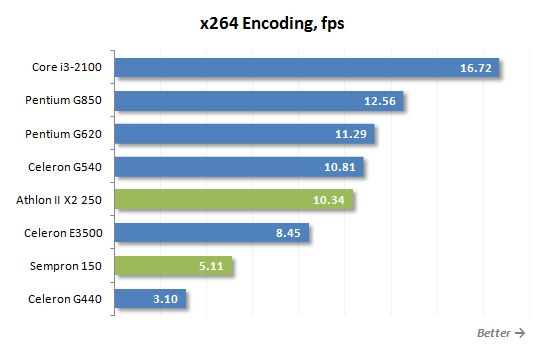
Celeron is a poor candidate for intensive multi-threaded loads, such as video transcoding, for example. Even a dual-core CPU with Hyper-Threading support can deliver much higher speed. However, the new Celeron G540 still looks awesome compared with the older processors from the same price range, such as Athlon II X2 250 and Celeron E3500.
We use special Cinebench test to measure the final rendering speed in Maxon Cinema 4D.
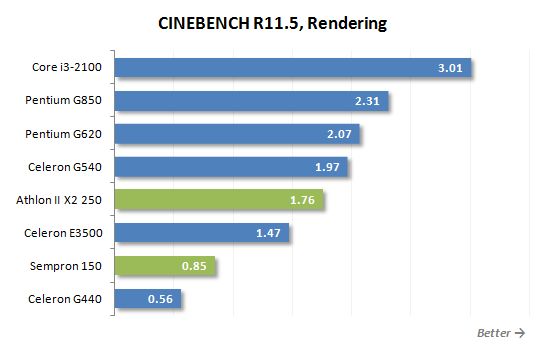
We see the same during rendering: Celeron G540 keeps it up and doesn’t give in to the similarly priced processors for other platforms. However, Celeron G440 doesn’t do so well. It looks very bad even among low-cost desktop processors from older generations, and obviously shouldn’t attempt to compete against Athlon II and Celeron as well as AMD Zacate and Intel Atom.
Gaming Performance
As you know, it is the graphics subsystem that determines the performance of the entire platform equipped with high-speed processors in the majority of contemporary games. Therefore, we do our best to make sure that the graphics card is not loaded too heavily during the test session: we select the most CPU-dependent tests and all tests are performed without antialiasing and in far not the highest screen resolutions. In other words, obtained results allow us to analyze not that much the fps rate that can be achieved in systems equipped with contemporary graphics accelerators, but rather how well contemporary processors can cope with gaming workload. Therefore, the results help us determine how the tested CPUs will behave in the nearest future, when new faster graphics card generations will be widely available.
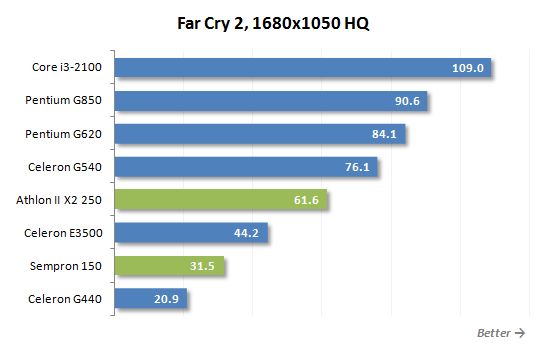
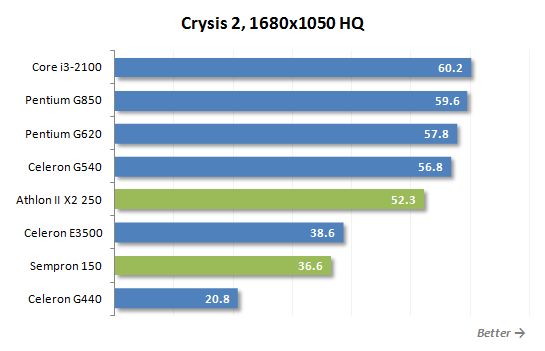
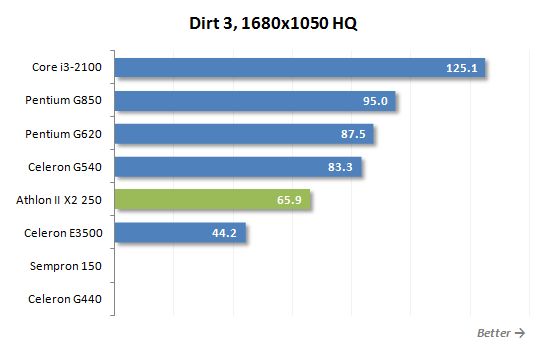
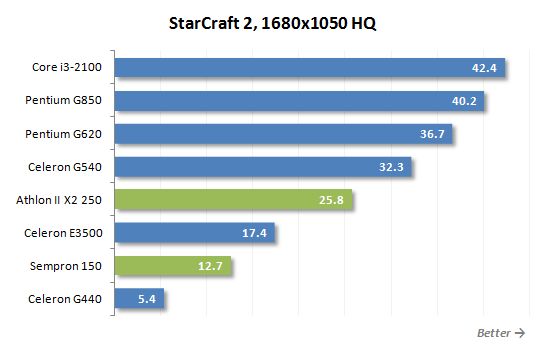
Sandy Bridge microarchitecture has always performed very well in 3D games. And today is no exception. Unlike their predecessors, the new Celeron processors can deliver much higher fps rate. Moreover, the difference between the Celeron and Pentium processors doesn’t seem that significant at all, so low-cost Celeron G540 or Celeron G530 processors may be a good option for inexpensive gaming systems after all. However, I can’t say the same thing about the single-core Celeron G440, which is unable to run many contemporary games, which require at least two computational cores.
Power Consumption
Although new LGA1155 Celeron processors have declared 65 W TDP, like other dual-core processors designed for the same platform, it doesn’t mean anything in reality. In the real world they should be more energy-efficient, because they work at low clock speeds and have a small L3 cache. To check whether this assumption is correct, we performed additional testing.
The graphs below show the full power draw of the computer (without the monitor) measured after the power supply. It is the total of the power consumption of all the system components. The PSU’s efficiency is not taken into account. The CPUs are loaded by running the 64-bit LinX 0.6.4 utility. We enabled all the power-saving technologies for correct measurement of the computer’s power draw in idle mode: C1E, AMD Cool’n’Quiet and Enhanced Intel SpeedStep.
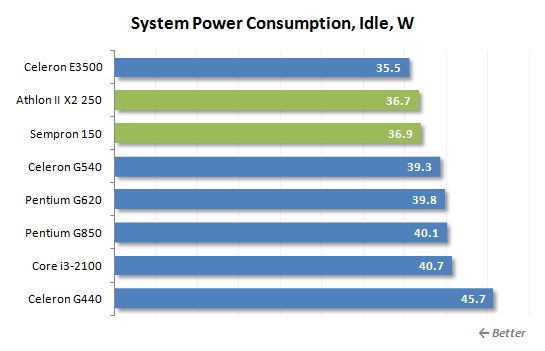
Things are quite what we expected them to be in idle mode. Celeron G540 based system needs a little less power than a similar system based on a Pentium processor. However, Socket AM3 or LGA775 platforms with older and simpler CPUs of the same class inside consume about 2-3 watts less.
I would like to say a few words about Celeron G440. This CPU consumes in idle mode so much power because it doesn’t support EIST and doesn’t drop its Vcore in this case.
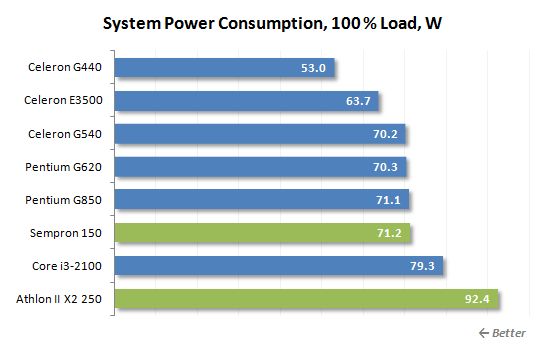
Under peak load the situation changes just a little. Celeron G540 can’t retain the title of the most energy-efficient CPU in our today’s test session. The system with the older Celeron E3500 consumes much less power. Although in terms of dedicated performance per watt, faster Sandy Bridge will be beyond competition.
Intel Celeron G440 vs. AMD E-350
I have to admit that Celeron G440 didn’t do that well in the company of other LGA1155 processors. It has only one core, works at low clock frequency, has a small cache – in other words, this very inexpensive product needs to be compared against other competitors different from the regular desktop dual-core processors. In our opinion, Intel Atom and AMD Brazos platforms targeted primarily for nettop computer systems will be the best rivals for it.
Let’s think outloud. A Mini-ITX platform that includes an inexpensive LGA1155 mainboard on Intel H61 chipset and a 37-dollar Celeron G440 CPU with an integrated graphics core will cost around $110. AMD E-350 based mainboards cost about the same. So, it looks like Intel’s plan for this strange single-core CPU was indeed to offer a worthy alternative to AMD Brazos platform that is convincingly faster than Intel’s Atom-based platforms, even those with Nvidia graphics inside.
In fact, Celeron G440 may be great in this role. It has a high-performance computational core with contemporary microarchitecture, has low power consumption (due to low clock speed) and has integrated HD Graphics core supporting DirectX 10 and hardware acceleration of video playback. Of course, having only one core is a small concern at this point, but on the other hand this CPU has a dual-channel memory controller, which should be very useful for instances when integrated graphics is involved.
In order to compare Celeron G440 and AMD E-350 side by side, we put together two similar Mini-ITX systems. They were an Intel system with Celeron G440 and Asus P8H61-I mainboard on H61 chipset, and an AMD Brazos system with Gigabyte GA-E350N-USB3 mainboard. Moreover, for comparison purposes we also included the results of the third platform based on Atom D525 and Gigabyte GA-D525TUD mainboard.
The table below compares the specifications of all three tested platforms side by side:
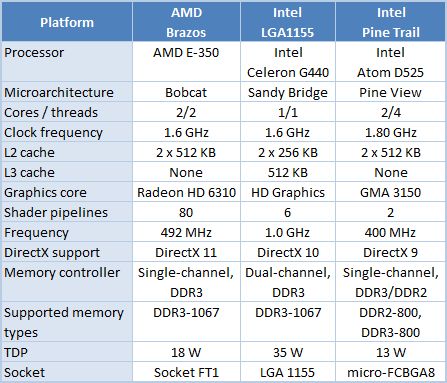
When we compared our Mini-ITX platforms, we used only integrated graphics adapters.
The specifications above show that Intel decided not to openly position their Celeron G440 processor in the same class with Atom and E-350. The TDP of the single-core Celeron processor is 2-3 times higher than the same parameter of classical nettop processors. However, calculated TDP is not always the same as the actual one, especially in Intel products. So, we decided to start our analysis with power consumption tests.
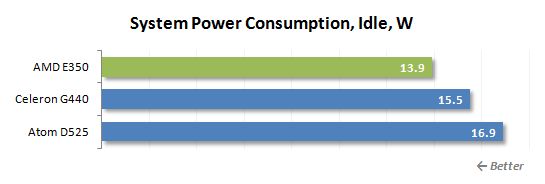
In idle mode Celeron G440 processor fits nicely into the same niche as Atom D525 and E-350. It is a pity that Intel disabled its EIST technology, because if they hadn’t done so, the new Celeron could have demonstrated even lower power consumption readings. But even in its current state, we have no complaints about excessive power consumption of the LGA1155 system.
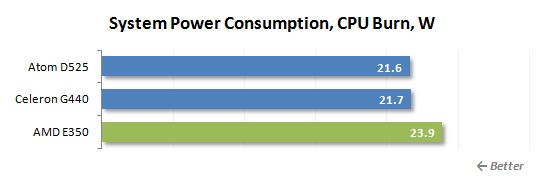
During maximum CPU utilization, the single-core Celeron G440 also consumes the amount of power comparable with that by Atom and Zacate. And it is a very important result. Now we have absolutely no doubts that the new Celeron G440 can easily compete against energy-efficient Atom D525 and AMD E-350.
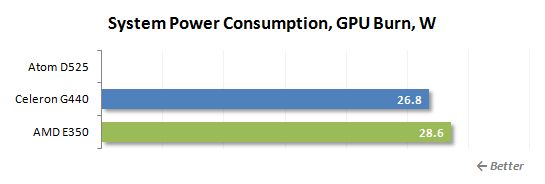
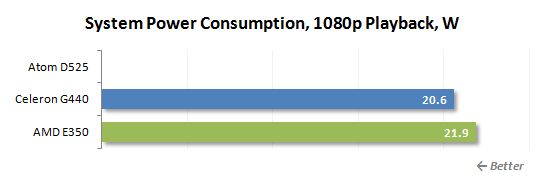
We can say the same after the tests of the graphics core power consumption. The E-350 and the LGA1155 based systems consume about the same amount of power during work with graphics and HD video playback. Atom is not on these diagrams because its graphics core doesn’t support contemporary API and doesn’t have sufficient resources for Full HD Video playback.
And what about performance? Can one Sandy Bridge core run as fast as dual-core processors, which Intel Atom or AMD Bobcat microarchitectures have been simplified for the sake of lowering their power consumption? Let’s take a closer look at SYSmark 2012 results.
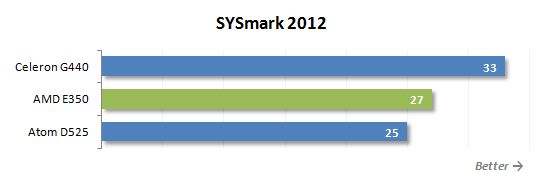
I have to say that things look very good for Celeron G440. Not only it doesn’t get defeated by its “lightweight” rivals, but is even way faster despite having only one computational core. It obviously owes its advantage to the ability of Sandy Bridge core to process more operations per clock cycle than Bobcat or Atom. And this difference is so significant that one Sandy Bridge core turns out better than two Bobcat or two Atom cores with Hyper-Threading support.
The table below shows the results obtained in different SYSmark 2012 scenarios:

We can see that Celeron G440 is ahead in many usage models and the only scenario where it loses to special nettop and netbook processors is 3D Modeling. This scenario focuses on final rendering that is why processors with simpler microarchitecture but capable of processing well-paralleled threads work faster than single-core Celeron G440.
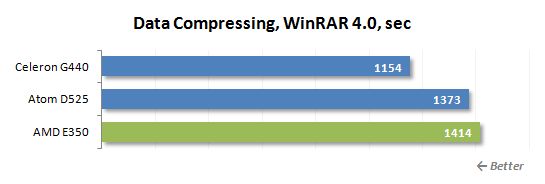
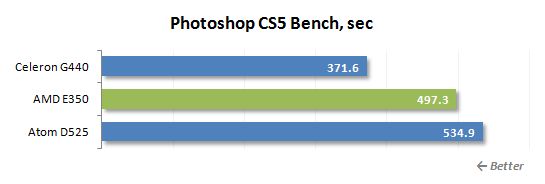
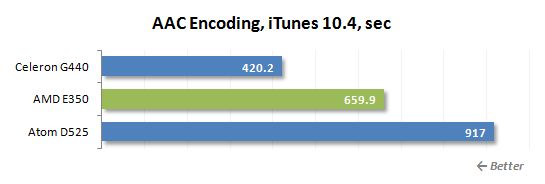
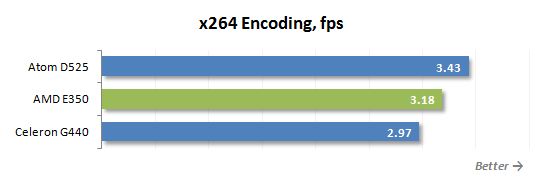
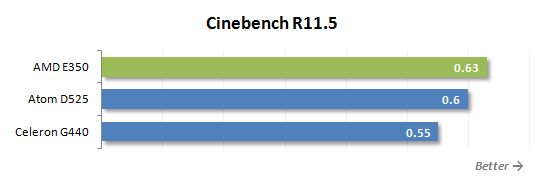
Tests in applications once again confirm that Celeron G440 almost always outperforms Atom D525 and E-350 except for the tasks that create simple multi-threaded computational load. Its only core can’t compete with dual-core nettop and netbook processors during tasks like final rendering or video transcoding. However, Celeron G440 does really well in all other more common nettop applications. Note that it is significantly faster in applications critical to the memory sub-system performance, because unlike Atom and Zacate it features a dual-channel memory controller supporting DDR3-1067 SDRAM.
AMD Brazos platform has become very popular mostly due to its decent graphics core that supports hardware decoding of popular video formats and in addition to DirectX 10 support copes with simple gaming loads. The graphics core inside Intel Atom processors, on the contrary, has been so severely simplified, that it doesn’t even support hardware HD video decoding, not to mention the embarrassing performance in 3D. Therefore, Atom is often bundled with Nvidia graphics, which makes systems using it more suitable for home.
Taking into account everything we have just said, Celeron G440 has all the chances to become a much more attractive Intel solution for home nettops and media centers. Its Intel HD Graphics core (a modification of HD Graphics 2000 with disabled Quick Sync technology) supports DirectX 10 and has a hardware decoder supporting all popular HD video formats. As a result, it can be easily installed into HTPC as is, although when it comes to 3D performance, things are not so rosy anymore.
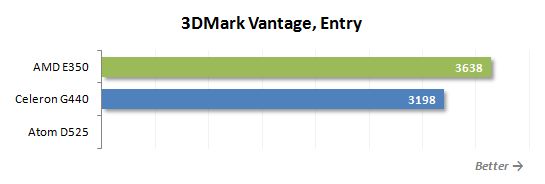
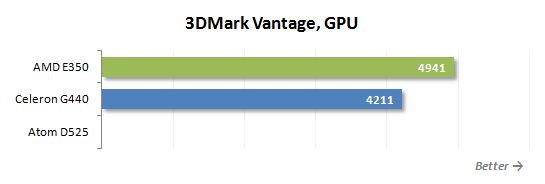
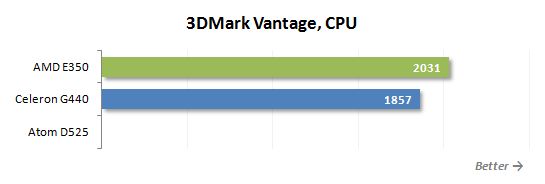
Celeron G440 performs quite well in the synthetic 3DMark Vantage suite. It is a little behind AMD E-350, but at the same time is fundamentally better than Atom, which cannot pass this test at all.
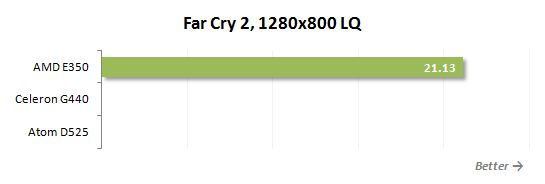
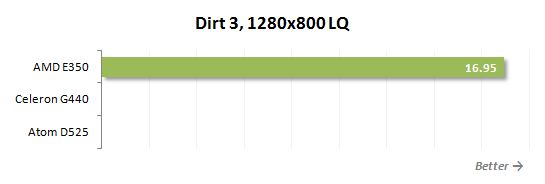
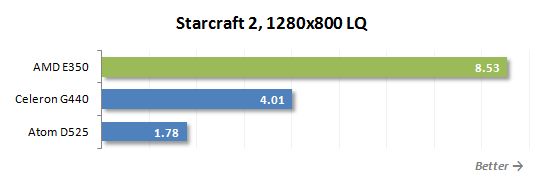
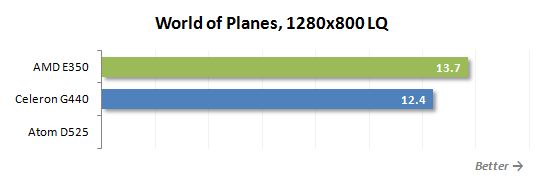
However, when it comes to real games, the single-core design doesn’t do Celeron G440 any good. Some games, like Dirt 3, simply refuse to load at all; others, like Far Cry 2, freeze in the process. In other words, Celeron G440 is hardly a good option for a low-cost gaming system. Besides, even if Celeron G440 works fine in some tests, AMD E-350 with the Radeon HD 6310 graphics core still beats it.
So, Celeron G440 is a pretty interesting product for compact energy-efficient nettops and media centers, which boasts impressive performance for solutions of this class and has hardware tools for HD video decoding. Moreover, a platform based on this LGA1155 processor is not only selling at the same price as AMD E-350 based systems, but also offers comparable power consumption and heat dissipation. Among obvious strengths of the new Celeron G440 I should point out possibility for future processor upgrade and the use of dual-channel memory controller. However, AMD Brazos platform still works better in 3D mode and under distinct multi-threaded load. Nevertheless, the new Celeron G440 should be considered an interesting alternative to contemporary Zacate processors, and especially Atom.
Conclusion
Frankly speaking, we have already tested all sorts of Sandy Bridge processors inside out by now. Therefore, at this point it is difficult to find anything new to add to what we have already mentioned in numerous reviews of dual-core processors on this microarchitecture. Especially, if we take into account the fact that new dual-core Celeron processors, which we have discussed in our today’s article are, in fact, hardly any different from LGA1155 Pentium processors launched a few months earlier.
Of course, if we look at the specifications, we will see that the new Celeron CPUs have lower clock frequencies and smaller L3 cache compared to Pentium. But the results of our tests show that it has very little effect on actual performance. There is no huge gap between LGA1155 Celeron and Pentium processors like the one we previously saw between Core i3 and Pentium CPUs. In other words, these two processor families are really close.
So, there is nothing surprising about the fact that the transition to LGA1155 platform has significantly boosted its performance compared with LGA775 predecessors. Sandy Bridge microarchitecture dramatically improved the performance of entry-level systems: by 50% on average and sometimes even twice as much. Moreover, new Celeron processors acquired a pretty decent HD Graphics core, so if you are choosing between different Celeron families, then there should be absolutely no doubts which one to prefer.
However, everything I have just said refers primarily to Celeron G540 and Celeron G530. However, there is also a very interesting Celeron G440 model that stands out from the rest of the line-up. This is a single-core processor with minimal clock speed, which, in fact, shouldn’t be called Celeron to begin with. But if we disregard this inconsistency and look at it as a nettop product, like Atom, for example, it will look way better. While its power consumption is at comparable level with the rivals’, it offers slightly better computational performance and radically better graphics, which is also capable of hardware HD video decoding. As a result, Celeron G440 based platforms can successfully compete with AMD Brazos in many aspects, including price. And even though E-350 processors appeal to users with their more advanced graphics, Celeron G440 CPUs boast higher average performance in regular applications and flexibility for future upgrades.
In conclusion I have to say that numerous launches of Sandy Bridge processors made LGA1155 platform so universally overwhelming that is became capable of handling the needs of a wide range of users. LGA1155 processors may be installed into high-performance systems as well as mainstream and entry-level ones. And with the launch of LGA1155 Celerons it will penetrate even the lowest-price systems and nettops. In other words, Intel has clearly accomplished their plan to limit the number of current platforms, which no longer include LGA775 or LGA1156. And in a little while Sandy Bridge microarchitecture will be able to oust from the market Nehalem’s last representative – LGA1366 socket.